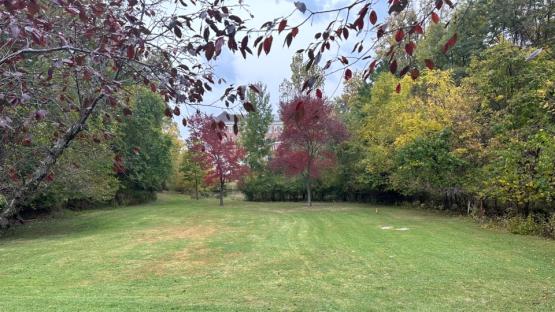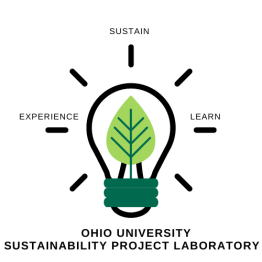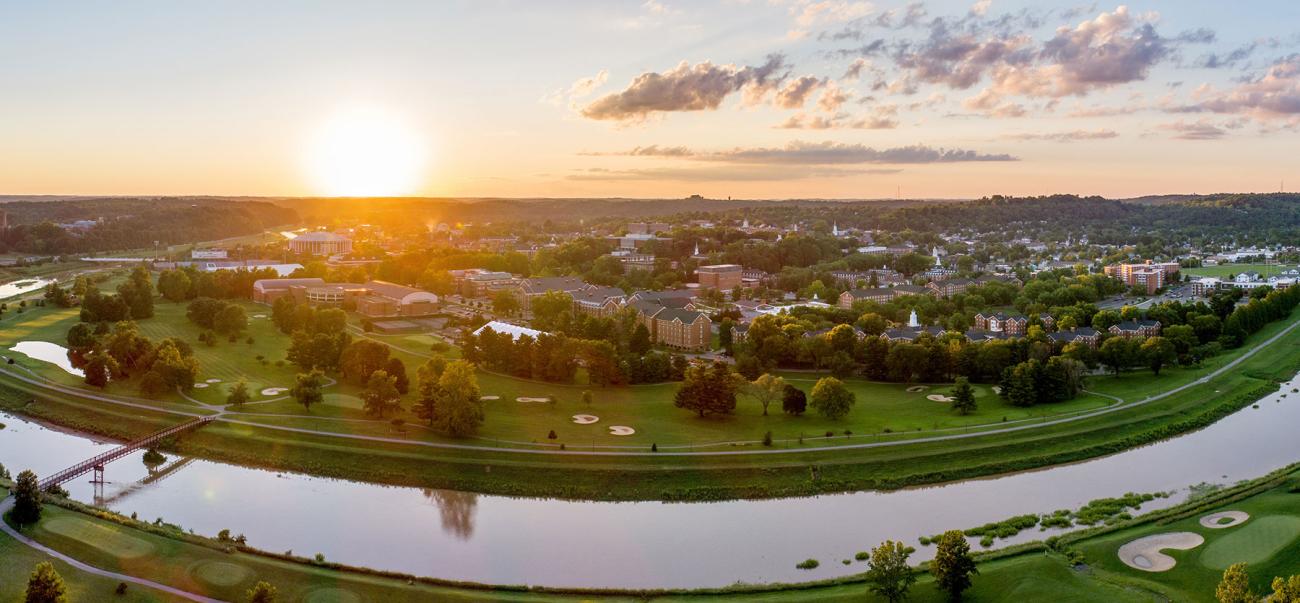
About "Campus is the Classroom"

" The Campus is the Classroom " initiative is an effort to bring teaching and learning out of the classroom and into the outdoors of Ohio University's campus, setting an example for other educational institutions. Sustainable Grounds of the Office of Sustainability aims to create and maintain healthy, natural, biodiverse and beautiful landscapes that can act as the foundation for sustainability-oriented experiential or outdoor learning opportunities. The OHIO campus is a place of pride for our students, alums, staff, faculty, and community members. OHIO has been awarded Tree Campus Higher Education for the sixth consecutive year for its commitment to creating a campus that is both accessible and environmentally friendly. As an affiliate of the Bee Campus USA, OHIO strives to improve its landscapes for pollinators. Thanks to our Grounds and Sustainability departments' whose hard work has contributed immensely to these accolades.
Vision:
- Reimagining the entire campus, both indoors and outdoors, as a potential learning space
- Designing the space for learning; designing the learning for the space
- Amplify and support the teaching and learning outdoors (TLO) that is already happening
- Expand opportunities and resources for those interested in TLO

The Sustainability Project Laboratory is a database of sustainability-related project proposals. This resource hosts projects and project ideas that can be adopted by faculty, staff, and students for course projects, capstone or senior projects, theses, and more. Search "Grounds" in the Project Database search bar on the Sustainability Project Laboratory page to find projects related to the Grounds theme.
Current Progess
Vision and Goals
Campus is the classroom is an initiative led by the Office of Sustainability to promote teaching and learning outdoors across OHIO's campuses. The goal of this initiative is to encourage faculty to utilize outdoor space to enhance theirteaching and learn how their environment can shape their pedagogical approach.
Promote teaching and learning outdoors on OHIO's campuses by:
- Reimagining the entire campus, particularly outdoor spaces, as learning spaces
- Designing the space for the learning; designing the learning for the space
- Amplifying and supporting the teaching and learning outdoors that is already happening
- Expanding opportunities and resources for those interested in teaching and learning outdoors
Support OHIO's 2021 Sustainability and Climate Action Plan:
- Grounds - create and maintain landscapes that act as the foundation for sustainability-oriented experiential
learning opportunities - Student Life - support and promote student wellbeing and resilience, prioritize diversity and inclusion as
positive student attributes in recruitment and retention - Curriculum - increase opportunities for formal, experiential, and community-engaged sustainable learning
experiences
Research supporting teaching and learning outdoors
Outdoor learning spaces in higher education grew during the COVID-19 pandemic, but their adoption as a pedagogical approach at the university level has not yet been fully explored. Literature suggests that time spent in natural environments has cognitive and emotional benefits. Kaplan (1995) describes nature as a restorative environment that can replenish directed attention, which is depleted extended periods of focus. Norwood, Lakhani, and Kendall (2021) found that teaching and learning outdoors had benefits for studentsfrom disadvantaged backgrounds. These findings suggest that finding ways to increase teaching and learning outdoors in higher education may have a positive impact on students.
Fall 2022 Survey
As part of an initiative to explore the use of outdoor classrooms, a survey was conducted among students and faculty at Ohio University in Fall 2022 by Kyle Butler, Sustainable Living Hub Coordinator, and Joshua Osondu, Graduate Assistant. The study gathered insights from 158 students and 49 faculty members about their experiences and attitudes toward holding classes in open, outdoor spaces on campus such as College Green and The Ridges. The findings highlight a strong interest and appreciation for outdoor learning environments from both groups, as well as important considerations for making such spaces more functional and comfortable.
Among students, 80% had experienced at least one class held outdoors. They emphasized benefits such as improved mood, emotional wellbeing, increased engagement, increased focus and motivation, enhanced learning experience, and the refreshing change of scenery. Common themes included enjoyment of nature, mental health benefits, interactive learning, and enhanced learning focus. However, students also noted challenges such as weather discomfort, distractions, and lack of proper seating or technological support. Despite these issues, the majority expressed interest in having more outdoor classes, with many suggesting practical improvements like better seating, Wi-Fi access, and advance preparation.
Faculty responses showed that nearly 69% had previously held classes outdoors, and many were open to doing so more frequently. Key barriers included weather unpredictability, lack of technological infrastructure, and limited access to suitable outdoor facilities. When asked what would encourage more outdoor teaching, instructors cited the need for designated, well-equipped spaces with shade, seating, power access, and digital teaching tools. A majority indicated they would consider using outdoor classrooms regularly if these supports were in place. Notably, they advocated for a dedicated outdoor classroom spaces, drawing from positive experiences during the pandemic when such settings became more common.
The results from both groups suggest a growing appreciation for outdoor learning spaces as enriching and effective alternatives to traditional indoor settings.
Classifying Outdoor Learning Spaces
Outdoor learning spaces will be categorized into three types based on attributes and function of the space and process for use.
Informal Learning Spaces
- Characterized by a sense of openness and availability.
- Spaces that can be used on a whim if the weather is nice - a chance to
get outside - May not be equipped with additional support materials
- Reservation may not be required
Formal Learning Spaces
- Structured learning environments
- Equipped with typical classroom materials: white/chalkboards, seating, WiFi
- Listed in ASTRA and reserved like any other classroom space
Nature Spaces
- Already outdoor learning environments as they currently are.
- No additional items besides site signage
- Utilized on a first-come, first-serve basis
Examples:
- Ridges Land Lab
- College green
- Emeriti park
- Bicentennial Park
Provisioned Spaces
- Enhanced outdoor learning environment.
- Teaching & Learning Outdoors Box: hold teaching materials such as clipboards, cushions, handheld whiteboards, etc, and signage
- May be reserved or used on a first-come, first-serve basis
Examples:
- Wolfe Garden
- Bentley Terrace
- MemAud's West Portico
- Seigfred Amphitheater
Outdoor Classrooms
- Fully-functioning, formal learning spaces, scheduled and reserved through ASTRA
- Include seating, chalkboard and additional tech
- Designed for instructional flexibility and active learning
Examples:
- Greenspace next to Muck
- Emeriti Park lawn
- Former Scott Quad site
- Arts and Education Green (after COFA renewal)
Nature Spaces
Goals:
- Highlight the beauty of open, public spaces that already exist across campus. No additional footprint would be added to the space besides appropriate signage indicating what the space is and any relevant OHIO History.
- The Sustainable Living Hub is creating a guide with pedagogical approaches that would be appropriate for these spaces.
Provisioned Spaces
Goals:
- Enhance an existing outdoor space to become a learning environments with minimal contributions. Space may already be equipped with adequate WiFi, power, etc.
- Teaching and Learning Outdoor Boxes would be installed in provisioned spaces.
Outdoor Classrooms
Goals:
- Sites that are appropriate for the construction of outdoor classrooms. The outdoor classrooms would be fully-functioning, formal learning spaces reserved through ASTRA.
- Outdoor classrooms allow for additional uses throughout multiple seasons
- Spaces would be designed for instructional flexibility and active, student-centered learning.
Process and steps for implementation
- Review Planning approach and intentions/priorities with appropriate stakeholders for feedback
- Once priorities are set and concept approved..
Moving forward for implementation:
-
Spaces and their attributes will be listed in the Building Directory
• Request an expansion to be Ohio University's Building and Space Directory. Would include outdoor spaces, if a reservation is required and who is the contact/department responsible for the space.
• Need to confirm if spaces are currently 'managed' by a campus department and add any relevant reservation information. If a space already has a reservation process, do we remove it from theCampus is the Classroom list of spaces?
• Is there a space on the Office of Sustainability's website where this information could also live? - Determine process for management and upkeep of designated spaces.
• Finalize funding needs for spaces, including signage, initial TLO boxes. - Provide signage and advertise to faculty to encourage usage
- Pilot one Teaching and Learning Outdoor Boxes in a provisioned space. Sustainability will conduct periodic checks on equipment, University Planning will conduct checks on use and grounds upkeep, and CTLA will assist in overall assessment.

